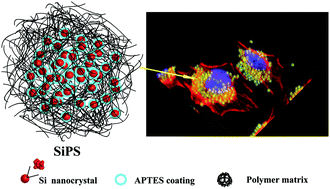In situ growth of fluorescent silicon nanocrystals in a monolithic microcapsule as a photostable, versatile platform†
Abstract
A facile, one-step method was developed for the in situ formation of fluorescent silicon nanocrystals (SiNC) in a microspherical encapsulating matrix. The obtained SiNC encapsulated polymeric microcapsules (SiPM) possess uniform size (0.1–2.0 μm), strong fluorescence, and nanoporous structure. A unique two stage, time dependent reaction was developed, as the growth of SiNC was slower than the formation of polymeric microcapsules. The resulting SiPM with increasing reaction time exhibited two levels of stability, and correspondingly, the release of SiNC in aqueous media showed different behavior. With reaction time <1 h, the obtained low-density SiPM (LD-SiPM) as matrix microcapsules, would release encapsulated SiNC on demand. With >1 h reaction time, resulting high-density SiPM (HD-SiPM) became stable SiNC reservoirs. SiPM exhibit stable photoluminescence. The porous structure and fluorescence quenching effects make SiPM suitable for bioimaging, drug loading and sorption of heavy metals (Hg2+ as shown) as an intrinsic indicator. SiPM were able to reduce metal ions, forming SiPM/metal oxide and SiPM/metal hybrids, and their applications in bio-sensing and catalysis were also demonstrated.


 Please wait while we load your content...
Please wait while we load your content...